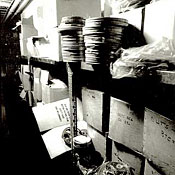|
||||||||||||||||||||||||||||||||||||||||||
| Home > CBC Archives Virtual Tour > Preservation and Restoration |
Yet by the time staff in CBC Radio Archives were able to attempt to catalogue and copy the sound from the original transcription disc, it was barely audible over clicks, hiss and other surface noise. Today? You can pull a small Digital Audio Tape (DAT) from the Radio Archives and listen to a restored clear, clean version of Willis's award-winning broadcasts (you can also listen to the original, unrestored version which is preserved on a separate channel). Such restoration and preservation miracles havelong been the core functions of CBC Archives. However, within the past decade, as people's appreciation for the archives has grown, so too has the amount of emphasis and activity in preservation and restoration. Several key projects began in 1994, and the efforts expanded greatly with the start of the Archives Project in 1998. While there is still more catching up to do, the CBC Archives have never been in better shape. Preservation and restoration are separate, but closely related, acts. Preservation work ensures that archival materials are captured as they are created, that they are accurately and thoroughly catalogued and filed, and that they are stored in conditions that prevent deterioration while keeping them accessible and within reach.
Restoration work deals chiefly with original, one-of-a-kind materials that have been neglected or damaged or are simply growing old. The goal is to return them as close to their original condition as possible. If that's not possible, they are restored to a point where, in the case of video, film and audio, the originals can at least be copied to new formats where they live on and can be used and appreciated for many years to come.
|
||||||||||||||||||||||||||||||||||||





